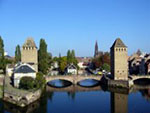to be confused with
the European Union) and its most important international organ, the European Court of
Human Rights. The legal importance of the ECHR cannot be overstated; it has
become, through its many thousand decisions from all parts of Europe, the
unofficial “supreme court of Europe.” Strasbourg is also official seat of the
European Parliament. Two architecturally modern and beautiful buildings along side
one of the canals house both the ECHR and the European Parliament. These and
the Council of Europe building can be visited if arrangements are made in
advance.
The second largest university in France, the University of
Strasbourg, is located there. Several fine museums are also available for visits,
including the Musee de l’Oeuvre Notre Dame located adjacent to the Cathedral.
The city also can claim a significant number of famous
personages who have lived there, including Johannes Gutenberg (inventor of the
movable type printing press – who has a city square named after him) John
Calvin, Johann Goethe, Louis Pasteur, and Albert Sweitzer.
Strasboug is served by a good transportation system, with
trains daily coming in and out of the City.
There are a number of significant sites to visit for the
judicial/legal traveler, beginning with the buildings that house the European
Parliament, located on one of the many canals that transverse the city. The
second site that is a must visit for the judicial/legal traveler is the nearby European Court
of Human Rights.

 International
Judicial Monitor
International
Judicial Monitor